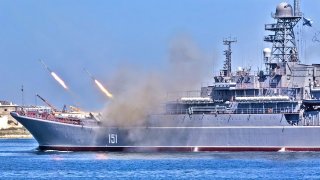The Russian Navy Might Be Making a Comeback
The Russian Navy continues to enhance its naval capabilities despite the prolonged sidelining of its flagship aircraft carrier, Admiral Kuznetsov. On Monday, the Navy welcomed the Amur, the sixth Project 22800 Karakurt-class missile corvette, into service.
Summary and Key Points You Need to Know: The Russian Navy continues to enhance its naval capabilities despite the prolonged sidelining of its flagship aircraft carrier, Admiral Kuznetsov. On Monday, the Navy welcomed the Amur, the sixth Project 22800 Karakurt-class missile corvette, into service.
-These small but potent vessels, designed by the Almaz Central Marine Design Bureau, are armed with Kalibr-NK or Oniks cruise missiles and a 76.2mm AK-176MA gun.
-The Karakurt-class corvettes are designed for green-water operations and can engage enemy strategic facilities and surface combatants. Originally, 18 ships were planned, but this has been reduced to 16.
Russia's Naval Power Grows: New Missile Corvette Amur Commissioned
The Russian Navy's flagship aircraft carrier Admiral Kuznetsov remains sidelined and out of service, undergoing a refit that has latest for more than half a decade, and questions continue as to whether the carrier could (or even should) return to the high seas again. Yet, the Russian Navy has continued its resurgence, with a focus on smaller, yet still highly capable vessels.
On Monday, the Russian Ministry of Defense announced that it had accepted the latest Project 22800 Karakurt-class missile corvette. Sixteen of the vessels have been planned, and the Amur is now the sixth to be delivered to the Russian Navy, with Commander-in-Chief of Russian Navy Admiral Aleksander Moiseyev in attendance.
"An official ceremony took place in Kaspiysk under the direction of Navy Commander-in-Chief Admiral Alexander Moiseyev to accept the Project 22800 missile corvette Amur for service and raise the St. Andrew's flag aboard it," the Russian ministry said in a statement to Tass.
"From now on, a new ship will defend national interests of our great Motherland," stated Moiseyev.
"Karakurt-class ships designed by engineers of the Almaz Central Marine Design Bureau embody the power of strike weapons and high seaworthiness characteristics," Moiseyev added. "They will make their weighty contribution to strengthening combat potential, operating within the Russian Navy's surface component. I am confident that the crew of the Amur missile corvette will be accomplishing assigned combat missions with honor. I want to thank the entire workforce of the Shipyard and the corporation for their invaluable contribution to strengthening the Russian Navy's combat might."
Russia's Naval Forces: Small but Armed
Though small vessels that display just 860 tons and are just 219 feet in length, the Russia corvettes are reported to be armed with eight Kalibr-NK or Oniks anti-ship cruise missiles. Additional armament consists of a 76.2mm 59-caliber AK-176MA 100mm A-190 automatic dual-purpose gun.

The Project 22800 Karakurt-class missile corvettes were designed by the Almaz Central Marine Design Bureau in St. Petersburg to engage with an enemy's strategic facilities in so-called green waters, including around coastal defenses and offshore installations. The vessels were intended to serve as a more seaworthy, blue-water complement to the Russian Navy's Buyan-M-class corvettes that operate in littoral zones.
These corvettes can target hostile surface combatants and take on various threats individually or in conjunction with other forces – even repelling enemy air attacks.
State media stated that the Project 22800 ships have a displacement of 800-900 tons and can maintain a top speed of 30 knots, a cruising capacity of 12 days, and a range of 2500 miles. The vessels are operated by a crew of 39 sailors and officers.
A total of 18 warships from Project 22800 were originally planned for the Russian Navy, but that has been scaled back to 16. Four had been in active service, while a fifth – Askold – was reportedly hit by a Ukrainian cruise missile in November 2023 and damaged beyond repair.
Author Experience and Expertise: Peter Suciu
Peter Suciu is a Michigan-based writer. He has contributed to more than four dozen magazines, newspapers, and websites with over 3,200 published pieces over a twenty-year career in journalism. He regularly writes about military hardware, firearms history, cybersecurity, politics, and international affairs. Peter is also a Contributing Writer for Forbes and Clearance Jobs. You can follow him on Twitter: @PeterSuciu. You can email the author: [email protected].
Image Credit: Creative Commons and Shutterstock.


